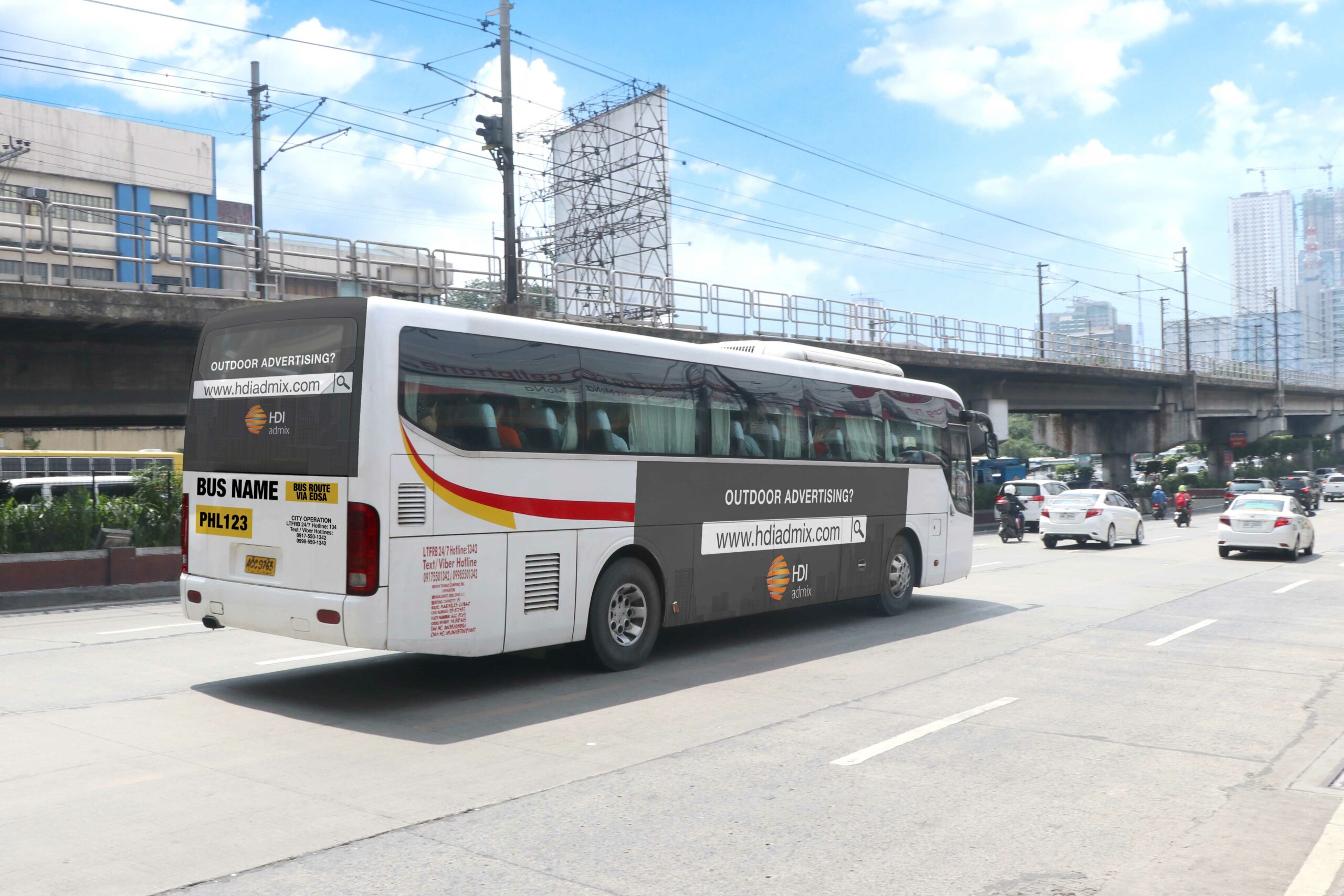Optimize Exposure with Transit Advertising Philippines
Optimize Exposure with Transit Advertising Philippines
Blog Article
Comprehending the Duty of Transportation Advertising in Enhancing Brand Name Visibility and Customer Interaction
Transportation advertising has actually arised as a crucial component in the advertising and marketing landscape, using unique chances for brands to raise their presence and involve consumers properly. With the capacity to reach a captive and diverse audience during their day-to-day commutes, these marketing approaches are not just regarding exposure; they have to do with creating purposeful connections with possible customers. As we discover the complex benefits and ingenious strategies within transit advertising and marketing, it becomes crucial to consider how these components collectively affect consumer assumption and actions, increasing concerns regarding their long-term impact on brand name loyalty.
Meaning of Transportation Advertising
Transit advertising describes the technique of promoting products, services, or brands with advertisements positioned around mass transit systems. This form of advertising includes a range of placements, consisting of posters on buses and trains, digital screens at transit terminals, and wraps on the outside of automobiles. It aims to get to a varied audience, maximizing the high foot traffic connected with public transportation.
Transit advertising and marketing is tactically placed to catch the interest of commuters, that usually spend significant time waiting or taking a trip. By incorporating ads into the everyday routines of individuals, brands can develop a long-term perception and foster brand name acknowledgment. The tool is specifically reliable in metropolitan environments, where mass transit is a primary mode of travel.
In addition, transit advertising and marketing can promote localized targeting, enabling companies to get to details demographics based on transportation paths and terminal places. As urban populations expand and using public transportation boosts, this advertising method has gained prestige as an essential part of incorporated marketing approaches. The vibrant nature of transit advertising, incorporated with its capacity to involve consumers in a captive environment, highlights its importance in modern advertising and marketing techniques.
Advantages of Transit Marketing
The effectiveness of transportation marketing depends on its ability to supply a wide variety of advantages to brand names seeking to enhance visibility and engagement. One of the key advantages is the comprehensive reach it offers; transit advertisements can efficiently target varied demographics across urban areas, getting to both pedestrians and commuters alike. This broad exposure considerably enhances brand name awareness.
One more benefit is the high regularity of impacts. As transportation cars take a trip along well-known routes and quit at multiple locations, they produce repeated exposure that strengthens brand messages. This regularity cultivates knowledge, which is crucial in customer decision-making.
Transit advertising and marketing is additionally affordable contrasted to other media systems. Given its extensive reach and capacity for high impressions, brands typically experience a reduced expense per thousand impressions (CPM), maximizing their advertising budget.
Additionally, transit advertisements can create a sense of area link. By straightening with neighborhood transit systems, brand names can resonate with regional target markets and promote a feeling of neighborhood pride. This local approach improves brand commitment and involvement, making transportation marketing a compelling choice for organizations aiming to solidify their existence out there.

Effective Strategies for Transit Projects
To optimize the impact of transportation campaigns, brands should take advantage of critical preparation and implementation tailored to their target audience. Initially, identifying the group characteristics of the audience using public transportation is important. This allows brands to produce personalized messaging that resonates with prospective consumers.
Next, picking the best transportation tools is necessary. Whether using bus wraps, subway posters, or electronic screens, each medium has special benefits that can boost exposure. As an example, lively visuals on bus wraps can draw in interest, while electronic Continued ads can be upgraded regularly to reflect prompt promos.
Additionally, incorporating a cohesive branding method throughout transit systems guarantees uniformity and enhances the brand name's identification. Making use of distinctive designs and remarkable taglines will reinforce brand recall among travelers.
By employing these strategies, More Help brand names can properly harness the capacity of transportation advertising, promoting better recognition and connection with their target audience. Inevitably, a well-executed transportation campaign can drive significant development in brand name visibility and customer involvement.

Determining Impact and Interaction
In assessing the efficiency of transit ad campaign, precise dimension of effect and engagement is important for brands seeking to enhance their advertising and marketing techniques. Metrics such as reach, regularity, and perceptions provide fundamental data to evaluate visibility. Assessing these factors assists establish how numerous potential consumers are subjected to the promotions throughout their day-to-day commutes.
Involvement can be further gauged with consumer communications, such as web site web traffic, social networks points out, and straight actions to calls-to-action featured in the ads. Using tools like QR codes or distinct URLs can help with tracking of consumer actions directly linked to transportation campaigns. Surveys and feedback devices additionally serve as valuable approaches to gather qualitative data on consumer assumptions and recall of the advertisement.
Furthermore, advanced analytics and acknowledgment versions can correlate transit direct exposure with subsequent investing in behavior, using insights right into the roi. By employing a thorough method that combines measurable and qualitative steps, brands can establish a nuanced understanding of their transit advertising and marketing influence. Inevitably, this data-driven method allows brand names to fine-tune their campaigns, ensuring they reverberate efficiently with target market and boost general brand presence.
Study of Effective Campaigns
Effective transit marketing campaign function as compelling examples of exactly how effective strategies can boost brand name exposure and involvement. Transit Advertising Philippines. One notable case is the "I Love New york city" campaign, which transformed the city's image and attracted numerous visitors. By utilizing metro ads, billboards, and official site bus wraps, the project created a solid, cohesive brand identification, causing a substantial uptick in tourist and local service patronage
An additional excellent campaign is Coca-Cola's "Share a Coke" initiative, which leveraged transportation advertising to individualize the brand experience. By featuring preferred names on marketing materials throughout various transportation systems, Coca-Cola cultivated a deeper psychological link with consumers, urging them to share their experiences on social media.
Furthermore, the "Got Milk?" campaign efficiently used public transportation ads to get to a broad audience, enhancing the message of the importance of milk in a well balanced diet. The project saw a quantifiable rise in milk intake in target demographics.
These study show that when performed thoughtfully, transportation advertising can significantly boost brand exposure, foster customer interaction, and drive quantifiable results, demonstrating its crucial function in modern-day advertising approaches. - Transit Advertising Philippines
Conclusion
In verdict, transportation advertising acts as a vital tool for improving brand name visibility and promoting customer involvement. By utilizing strategically put advertisements within public transport systems, brands can properly reach diverse audiences and strengthen acknowledgment via regular exposure. The implementation of targeted messaging and ingenious methods better amplifies the influence of transportation campaigns. Eventually, the capability to determine involvement and assess effective study emphasizes the efficiency of transportation advertising in driving brand loyalty and customer communications.
Transportation marketing has emerged as a critical element in the advertising and marketing landscape, using special opportunities for brand names to boost their presence and engage customers properly.In addition, transit advertising can promote local targeting, enabling services to reach details demographics based on transportation routes and terminal places.In evaluating the efficiency of transportation marketing campaigns, exact measurement of influence and interaction is important for brand names seeking to maximize their advertising approaches.Successful transportation advertising projects serve as compelling instances of exactly how reliable approaches can boost brand presence and engagement.In verdict, transit marketing offers as an important tool for improving brand visibility and promoting customer engagement.
Report this page